 Quebec & Blenheim Platoon Passing Out Parade.
Quebec & Blenheim Platoon Passing Out Parade.
Bassingbourn Barracks – July 1991.
Video and information relating to the joint Quebec & Blenheim Platoon – Gym demonstration and passing out parade at Bassingbourn Barracks – 25th July 1991.
As far as I’m aware, at the time, Quebec platoon was the largest single platoon (45) to have ever successfully passed through training at Bassingbourn. (Not sure if that record still stands.)
Having at last had the video converted and now uploaded to YouTube, I think I need to allocate some time to writing about the time I spent at Bassingbourn Barracks and how gutted I am at its closure… I consider it an honour and a privilege to have trained and served here. I loved the place. I will hopefully get something down and published soon.
The inspecting Officer – Lt Col. MJ Boocock – Royal Anglian Regiment.
The Regimental Sgt Maj – WO1 (RSM) TP Gedge – Royal Anglian Regiment.
Parade Commander – Maj WD Rainey – Royal Pioneer Corps.
Parade Sgt Maj – WO2 GS McLane – Royal Pioneer Corps.
The Band – The 1st Battalion – The Royal Anglian Regiment.
(See video description on YouTube page for links to specific times.)
Quebec Platoon
Quebec Platoon Staff
Platoon Commander
cSgt MB King – Royal Regiment Fusiliers.
Platoon Sergeant
Sgt DS Dudley – Royal Pioneer Corps.
Platoon Corporals
Cpl Darnell – Royal Anglian Regiment.
Cpl Hughes – Royal Anglian Regiment.
Cpl Connolly – Royal Pioneer Corps.
Cpl Straker – Royal Regiment Fusiliers.
Quebec Infantry Soldiers
Blenheim Platoon
Blenheim Platoon Staff
Platoon Commander
Lt RJ Latham – Royal Anglian Regiment.
Platoon Sergeant
Sgt MA Tennent – Royal Regiment Fusiliers.
Blenheim Platoon Corporals
Cpl Cornhill – Queens Regiment.
Cpl Bird – Royal Regiment Fusiliers.
Cpl Horgan – Royal Regiment Fusiliers.
Cpl Rushton – Royal Regiment Fusiliers.
Blenheim Infantry Soldiers
Private Allum.
Private Barlo.
Private Blessing.
Private Burnette.
Private Coe.
Private Cooke.
Private Dealtry.
Private Devito.
Private Dowler.
Private Edwards.
Private Ellender.
Private English.
Private Evans.
Private Fairman.
Private Franklin.
Private Gautier.
Private Gibbs.
Private Harrison.
Private Henson.
Private Herbet.
Private King.
Private Kerwin.
Private Lawes-Cole.
Private Lorenz.
Private McIntosh.
Private Murton.
Private Paeth.
Private Rogers.
Private Rogerson.
Private Rousell.
Private Semple.
Private Sowden.
Private Spearman.
Private Sped.
Private Summerfield.
Private Tyler.
Private Watson.
Fusilier Feather.
Fusilier Gallon.
Fusilier Johnny.
Fusilier McMinn.
Fusilier Southern.
Fusilier Trowman.
Fusilier Williams.
Fusilier Williamson.
Private Black.
Private Blanchard.
Private Brown.
Private Buckman.
Private Buff.
Private Bunting.
Private Burton.
Private Coulthard.
Private Crowe.
Private Denton.
Private Docherty.
Private Donald.
Private Falconer.
Private Fisher.
Private Heatley.
Private Howard.
Private Huggins.
Private Mayall.
Private Moore.
Private New.
Private Panter.
Private Worledge.
Fusilier Allen.
Fusilier Bryne.
Fusilier Cooper.
Fusilier Good.
Fusilier Hedge.
Fusilier Hewitson.
Fusilier Taylor.
Fusilier Unsworth.
Bassingbourn Barracks, Royston, Cambridgeshire.
Royal Air Force Bassingbourn (RAF Bassingbourn) is a former Royal Air Force station located in Cambridgeshire. The barracks is approximately 3 mi (5 km) north of Royston, Hertfordshire. 11 mi (18 km) south west of Cambridge, Cambridgeshire, England.
During the Second World War Bassingbourn served first as an RAF station and then as a bomber airfield of the Eighth Air Force, of the United States Army Air Forces (USAAF). (The Memphis Belle).
Bassingbourn barracks were established, on the site of the former RAF Bassingbourn airfield, in January 1970. The barracks became known as the Depot for the Queen’s Division. The depot was responsible for training recruits. The recruits participated in 10 weeks basic training followed immediately with 11 weeks specialist infantry training before joining a regular battalion/corps/regiment.
During my time training the barracks trained The Royal Pioneer Corps, The Royal Anglian Regiment, Royal Regiment Fusilier and The Queen’s Regiment.
In 1993 the Barracks were re-designated the home of the “Army Training Regiment, Bassingbourn” and remained as such for nearly 20 years.
Unfortunately Bassingbourn Barracks closed as an army training location in August 2012.
The Memphis Belle
The B17 Flying Fortress the ‘Memphis Belle’ (Serial No. 41-24485) arrived Bassingbourn on the Oct 14 1942.
Named the ‘Memphis Belle’ by her Pilot Capt. Robert Morgan, after his sweetheart back at home, she flew her first mission on Nov 07 1942 to Brest in France. She would safely carry her crew, deliver their bomb load and return home again, a further 25 times. The Memphis Belle completed her 25th and final mission on May 17 1943.
Throughout her wartime service, the ‘Belle’ was bullet-ridden and flak damaged. On five separate occasions she had her engines shot out, and once returned to Bassingbourn with her tail almost shot off. Not a single member of her crew sustained any major injuries.
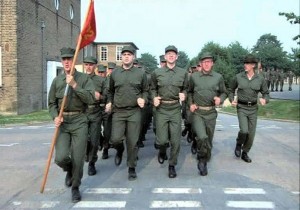 Full Metal Jacket
Full Metal Jacket
Bassingbourn Barracks was used for location filming of the movie Full Metal Jacket in 1985 standing-in for the Marine Corps Recruit Depot Parris Island, South Carolina. Other than the infamous training scenes, some of the Vietnam scenes were even filmed at Bassingbourn. Palm trees were even imported for the film and left on site afterward. (Guessing they didn’t survive too long.) British Army recruits based at Bassingbourn during the filming were used as extras.
Sources – Wiki & The Tower Museum


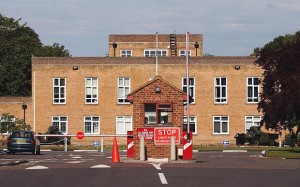
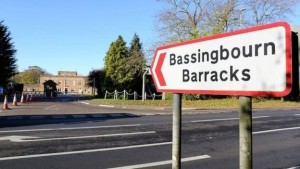
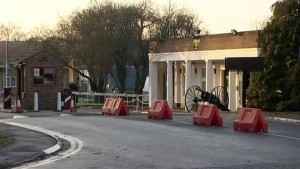
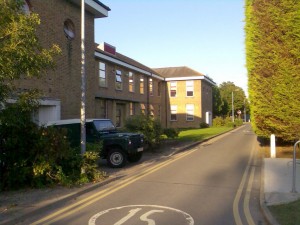
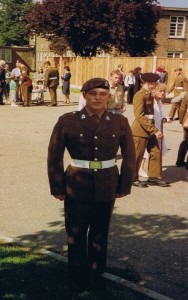
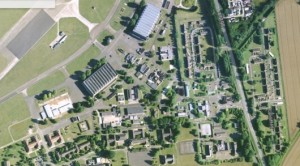
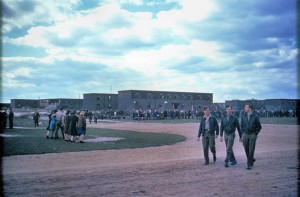
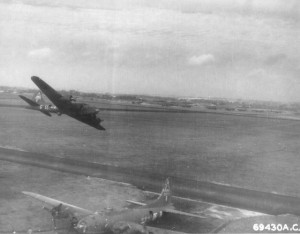
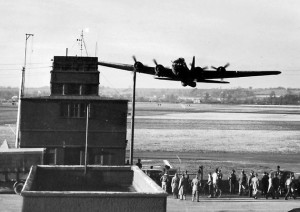
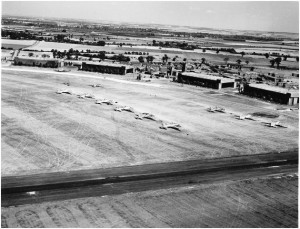
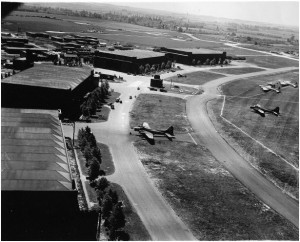
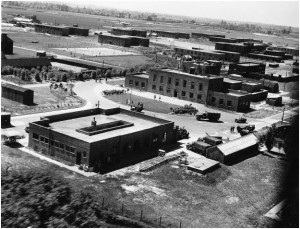
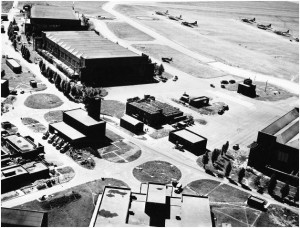
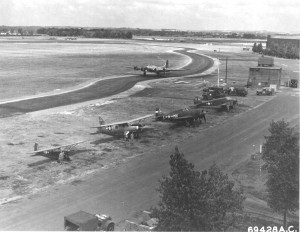
Leave A Comment
You must be logged in to post a comment.